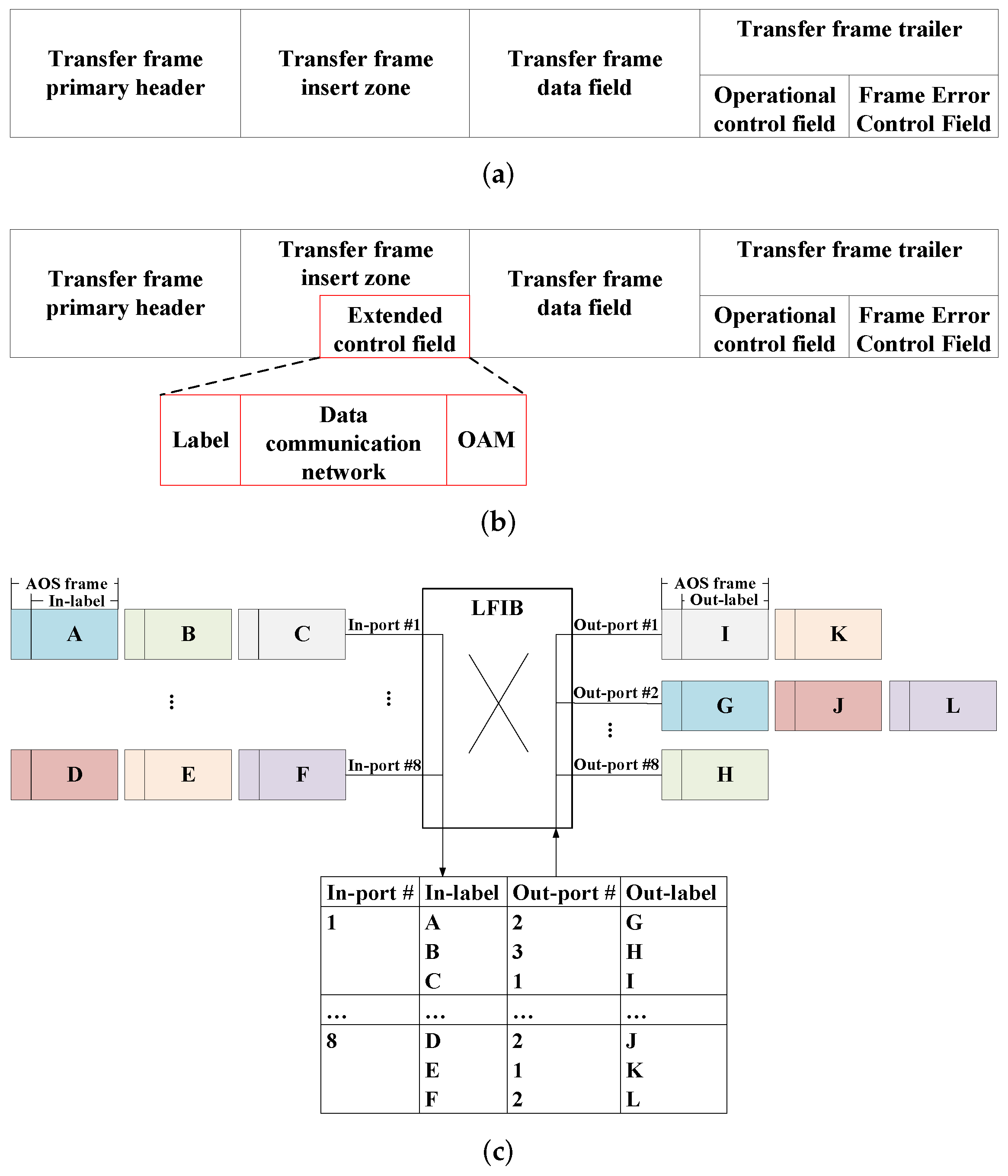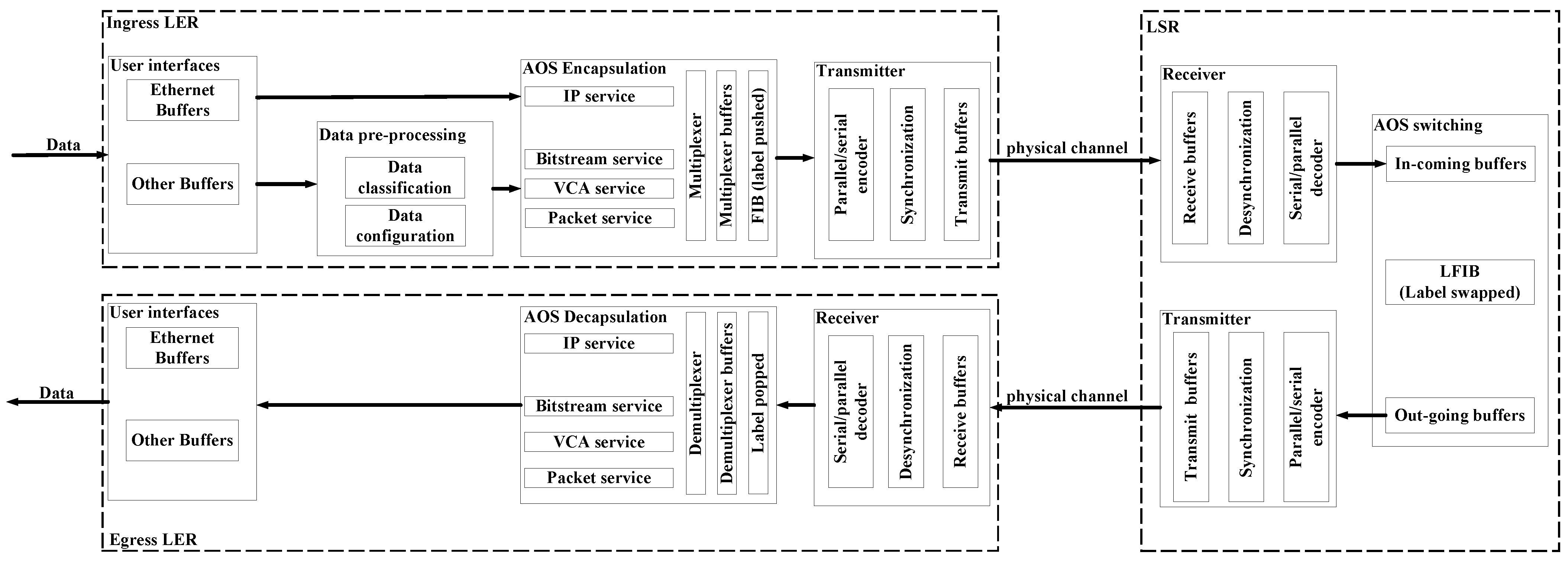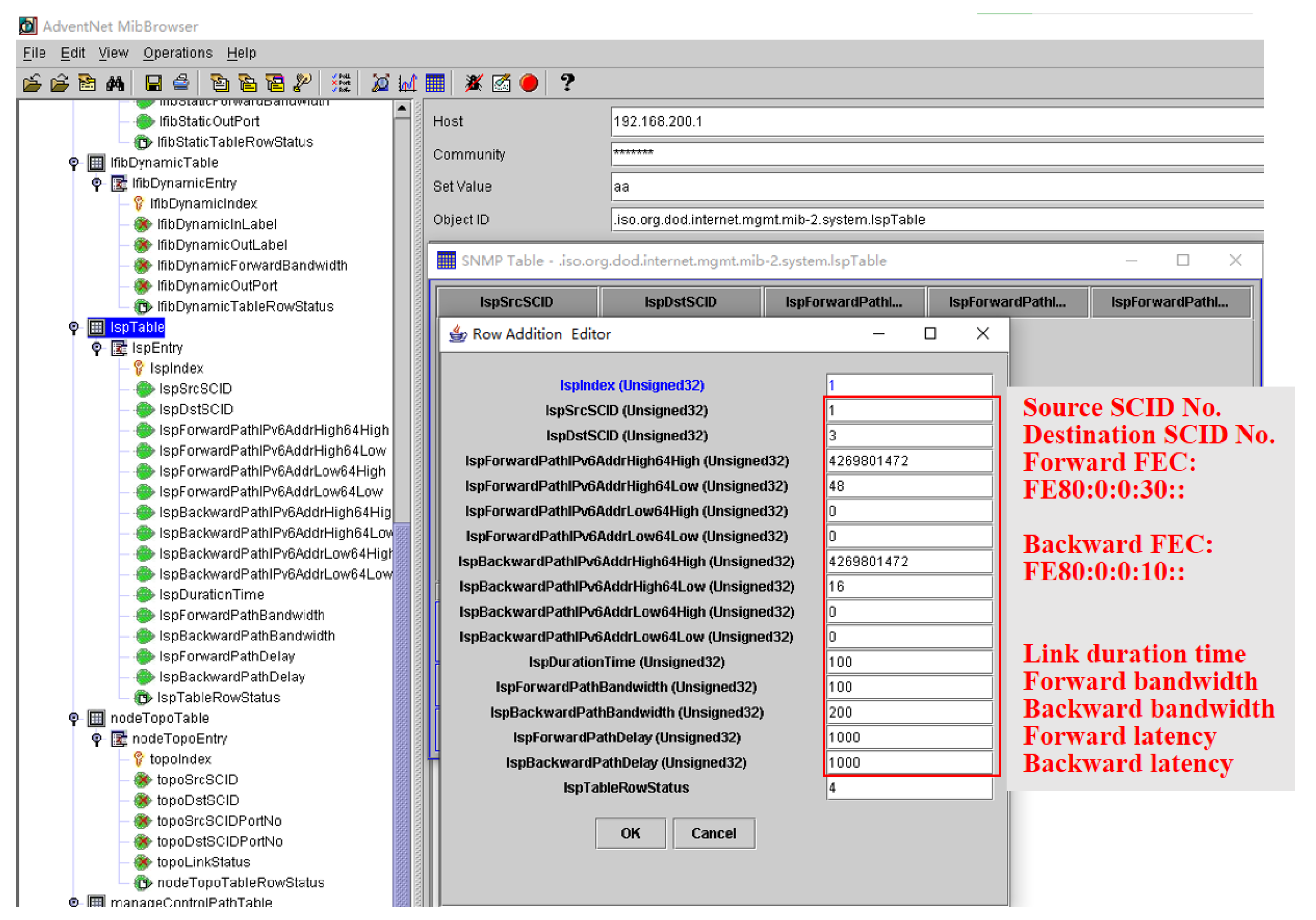Figure 1.
The typical application scenario of ISTNs.
Figure 1.
The typical application scenario of ISTNs.
Figure 2.
The label-based CCSDS AOS frame switching. (a) The CCSDS recommended AOS frame. (b) The proposed AOS frame with extended control field. (c) The principle of label swapping for the AOS frame according to LFIB.
Figure 2.
The label-based CCSDS AOS frame switching. (a) The CCSDS recommended AOS frame. (b) The proposed AOS frame with extended control field. (c) The principle of label swapping for the AOS frame according to LFIB.
Figure 3.
OSI reference model v.s. label-based extended CCSDS reference model.
Figure 3.
OSI reference model v.s. label-based extended CCSDS reference model.
Figure 4.
The framework of SDN-based ISTNs simulation platform.
Figure 4.
The framework of SDN-based ISTNs simulation platform.
Figure 5.
The transmission of a fixed bit length managing and controlling message in the data communication network field of the AOS frame.
Figure 5.
The transmission of a fixed bit length managing and controlling message in the data communication network field of the AOS frame.
Figure 6.
The protocol framework of ISTNs.
Figure 6.
The protocol framework of ISTNs.
Figure 7.
The functional block diagram of four types of service over AOS frame.
Figure 7.
The functional block diagram of four types of service over AOS frame.
Figure 8.
The topology of VxWorks simulated network.
Figure 8.
The topology of VxWorks simulated network.
Figure 9.
Link-state database of optimized OSPF in node vx_simulator_01 (SCID 1).
Figure 9.
Link-state database of optimized OSPF in node vx_simulator_01 (SCID 1).
Figure 10.
Simulation in software platform with 16 simulated nodes under the circumstances of bi-directional link. (a) The status of a neighbor’s ports, routing path for managing and controlling messages, and explicit constraint routing path for data under QoS requirements in node vx_simulator_01 (SCID 1). (b) The status of a neighbor’s ports in node vx_simulator_04 (SCID 4).
Figure 10.
Simulation in software platform with 16 simulated nodes under the circumstances of bi-directional link. (a) The status of a neighbor’s ports, routing path for managing and controlling messages, and explicit constraint routing path for data under QoS requirements in node vx_simulator_01 (SCID 1). (b) The status of a neighbor’s ports in node vx_simulator_04 (SCID 4).
Figure 11.
The principle of uni-directional OSPF protocol.
Figure 11.
The principle of uni-directional OSPF protocol.
Figure 12.
Simulation in the software platform with 16 simulated nodes under the circumstances of uni-directional link. (a) The status of a neighbor’s ports and explicit constraint routing path for data under QoS requirements in node vx_simulator_01 (SCID 1). (b) The status of a neighbor’s ports in node vx_simulator_04 (SCID 4).
Figure 12.
Simulation in the software platform with 16 simulated nodes under the circumstances of uni-directional link. (a) The status of a neighbor’s ports and explicit constraint routing path for data under QoS requirements in node vx_simulator_01 (SCID 1). (b) The status of a neighbor’s ports in node vx_simulator_04 (SCID 4).
Figure 13.
Flooding restraint and flooding procedure for the two scenarios of satellites link variation.
Figure 13.
Flooding restraint and flooding procedure for the two scenarios of satellites link variation.
Figure 14.
The semi-physical platform. (a) The semi-physical platform with VxWorks simulated nodes and FPGA boards. (b) The network topology of the semi-physical platform.
Figure 14.
The semi-physical platform. (a) The semi-physical platform with VxWorks simulated nodes and FPGA boards. (b) The network topology of the semi-physical platform.
Figure 15.
The SNMP MIB of the semi-physical platform.
Figure 15.
The SNMP MIB of the semi-physical platform.
Figure 16.
The configuration from the network management system to the remote node uses the data communication network overhead in the AOS frame. (a) The configuration of static forwarding information base from the network management system (SNMP manager). (b) The managing and controlling message of static FIB transmitted by node vx_simulator_01 through southbound interface.
Figure 16.
The configuration from the network management system to the remote node uses the data communication network overhead in the AOS frame. (a) The configuration of static forwarding information base from the network management system (SNMP manager). (b) The managing and controlling message of static FIB transmitted by node vx_simulator_01 through southbound interface.
Figure 17.
A data communication network sequence diagram for a managing and controlling message, i.e., static FIB, from node vx_simulator_01 (SCID 1) to node vx_simulator_02 (SCID 2).
Figure 17.
A data communication network sequence diagram for a managing and controlling message, i.e., static FIB, from node vx_simulator_01 (SCID 1) to node vx_simulator_02 (SCID 2).
Figure 18.
A data communication network sequence diagram for a management and controlling flooding message, i.e., satellite link plan of connections, from node vx_simulator_01 (SCID 1) to other nodes.
Figure 18.
A data communication network sequence diagram for a management and controlling flooding message, i.e., satellite link plan of connections, from node vx_simulator_01 (SCID 1) to other nodes.
Figure 19.
The link-state database of the optimized OSPF in node vx_simulator_01 (SCID 1). (a) The router link states of node vx_simulator_01 (SCID 1). (b) The router link states of node vx_simulator_02 (SCID 2). (c) The router link states of node vx_simulator_03 (SCID 3).
Figure 19.
The link-state database of the optimized OSPF in node vx_simulator_01 (SCID 1). (a) The router link states of node vx_simulator_01 (SCID 1). (b) The router link states of node vx_simulator_02 (SCID 2). (c) The router link states of node vx_simulator_03 (SCID 3).
Figure 20.
The explicit constraint data routing computation under QoS requirements and the circumstances of a bi-directional link between node vx_simulator_01 (ingress LER, SCID 1), node vx_simulator_02 (LSR, SCID 2), and node vx_simulator_03 (egress LER, SCID 3). (a) The status of a neighbor’s port and explicit bi-directional data routing path computation in node vx_simulator_01 (SCID 1). (b) The explicit uni-directional data routing path computation between node vx_simulator_01 (SCID 1) and node vx_simulator_03 (SCID 3). (c) The status of a neighbor’s port in node vx_simulator_02 (SCID 2).
Figure 20.
The explicit constraint data routing computation under QoS requirements and the circumstances of a bi-directional link between node vx_simulator_01 (ingress LER, SCID 1), node vx_simulator_02 (LSR, SCID 2), and node vx_simulator_03 (egress LER, SCID 3). (a) The status of a neighbor’s port and explicit bi-directional data routing path computation in node vx_simulator_01 (SCID 1). (b) The explicit uni-directional data routing path computation between node vx_simulator_01 (SCID 1) and node vx_simulator_03 (SCID 3). (c) The status of a neighbor’s port in node vx_simulator_02 (SCID 2).
Figure 21.
The label distribution process of label switching path setup under QoS requirements and the circumstances of a bi-directional link between node vx_simulator_01 (ingress LER, SCID 1), node vx_simulator_02 (LSR, SCID 2), and node vx_simulator_03 (egress LER, SCID 3) in the semi-physical platform. (a) The label distribution process in node vx_simulator_01 (SCID 1). (b) The label distribution process in node vx_simulator_02 (SCID 2). (c) The label distribution process in node vx_simulator_03 (SCID 3).
Figure 21.
The label distribution process of label switching path setup under QoS requirements and the circumstances of a bi-directional link between node vx_simulator_01 (ingress LER, SCID 1), node vx_simulator_02 (LSR, SCID 2), and node vx_simulator_03 (egress LER, SCID 3) in the semi-physical platform. (a) The label distribution process in node vx_simulator_01 (SCID 1). (b) The label distribution process in node vx_simulator_02 (SCID 2). (c) The label distribution process in node vx_simulator_03 (SCID 3).
Figure 22.
The label-based AOS frame switching in forward label switching path under the circumstances of bi-directional link between node vx_simulator_01 (ingress LER, SCID 1), node vx_simulator_02 (LSR, SCID 2) and node vx_simulator_03 (egress LER, SCID 3) in the semi-physical platform. (a) The IPv6 data transmitted from node vx_simulator_01 (SCID 1) to node vx_simulator_03 (SCID 3). (b) The forward-FIB-based label pushing of AOS frame in node vx_simulator_01 (SCID 1). (c) The forward-LFIB-based label swapping of AOS frame in node vx_simulator_02 (SCID 2). (d) The forward-FIB-based label popping of AOS frame in node vx_simulator_03 (SCID 3).
Figure 22.
The label-based AOS frame switching in forward label switching path under the circumstances of bi-directional link between node vx_simulator_01 (ingress LER, SCID 1), node vx_simulator_02 (LSR, SCID 2) and node vx_simulator_03 (egress LER, SCID 3) in the semi-physical platform. (a) The IPv6 data transmitted from node vx_simulator_01 (SCID 1) to node vx_simulator_03 (SCID 3). (b) The forward-FIB-based label pushing of AOS frame in node vx_simulator_01 (SCID 1). (c) The forward-LFIB-based label swapping of AOS frame in node vx_simulator_02 (SCID 2). (d) The forward-FIB-based label popping of AOS frame in node vx_simulator_03 (SCID 3).
Figure 23.
The label-based AOS frame switching in backward label switching path under the circumstances of bi-directional link between node vx_simulator_01 (ingress LER, SCID 1), node vx_simulator_02 (LSR, SCID 2), and node vx_simulator_03 (egress LER, SCID 3) in the semi-physical platform. (a) The IPv6 data transmitted from node vx_simulator_03 (SCID 3) to node vx_simulator_01 (SCID 1). (b) The backward-FIB-based label pushing of AOS frame in node vx_simulator_03 (SCID 3). (c) The backward-LFIB-based label swapping of AOS frame in node vx_simulator_02 (SCID 2). (d) The backward-FIB-based label popping of AOS frame in node vx_simulator_01 (SCID 1).
Figure 23.
The label-based AOS frame switching in backward label switching path under the circumstances of bi-directional link between node vx_simulator_01 (ingress LER, SCID 1), node vx_simulator_02 (LSR, SCID 2), and node vx_simulator_03 (egress LER, SCID 3) in the semi-physical platform. (a) The IPv6 data transmitted from node vx_simulator_03 (SCID 3) to node vx_simulator_01 (SCID 1). (b) The backward-FIB-based label pushing of AOS frame in node vx_simulator_03 (SCID 3). (c) The backward-LFIB-based label swapping of AOS frame in node vx_simulator_02 (SCID 2). (d) The backward-FIB-based label popping of AOS frame in node vx_simulator_01 (SCID 1).
Figure 24.
The explicit constraint data routing computation under QoS requirements and the circumstances of uni-directional link between node vx_simulator_01 (ingress LER, SCID 1, uni-directional sending), node vx_simulator_02 (LSR, SCID 2, uni-directional receiving), and node vx_simulator_03 (egress LER, SCID 3). (a) The status of a neighbor’s port and data routing computation in node vx_simulator_01. (b)The explicit uni-directional data routing path computation between node vx_simulator_01 and node vx_simulator_03. (c) The status of a neighbor’s port in node vx_simulator_02.
Figure 24.
The explicit constraint data routing computation under QoS requirements and the circumstances of uni-directional link between node vx_simulator_01 (ingress LER, SCID 1, uni-directional sending), node vx_simulator_02 (LSR, SCID 2, uni-directional receiving), and node vx_simulator_03 (egress LER, SCID 3). (a) The status of a neighbor’s port and data routing computation in node vx_simulator_01. (b)The explicit uni-directional data routing path computation between node vx_simulator_01 and node vx_simulator_03. (c) The status of a neighbor’s port in node vx_simulator_02.
Figure 25.
The label distribution process of label switching path setup under QoS requirements and the circumstances of uni-directional link between node vx_simulator_01 (ingress LER, SCID 1), node vx_simulator_02 (LSR, SCID 2), and node vx_simulator_03 (egress LER, SCID 3). (a) The label distribution process in node vx_simulator_01 (SCID 1). (b) The label distribution process in node vx_simulator_02 (SCID 2). (c) The label distribution process in node vx_simulator_03 (SCID 3).
Figure 25.
The label distribution process of label switching path setup under QoS requirements and the circumstances of uni-directional link between node vx_simulator_01 (ingress LER, SCID 1), node vx_simulator_02 (LSR, SCID 2), and node vx_simulator_03 (egress LER, SCID 3). (a) The label distribution process in node vx_simulator_01 (SCID 1). (b) The label distribution process in node vx_simulator_02 (SCID 2). (c) The label distribution process in node vx_simulator_03 (SCID 3).
Figure 26.
The label-based AOS frame switching in forward label switching path under the circumstances of uni-directional link between node vx_simulator_01 (uni-directional sending) and node vx_simulator_02 (uni-directional receiving) in the semi-physical platform. (a) The IPv6 data transmitted from node vx_simulator_01 (ingress LER, SCID 1) to node vx_simulator_03 (egress LER, SCID 3). (b) The forward-FIB-based label pushing of AOS frame in node vx_simulator_01 (SCID 1). (c) The forward-LFIB-based label swapping of AOS frame in node vx_simulator_02 (SCID 2). (d) The forward-FIB-based label popping of AOS frame in node vx_simulator_03 (SCID 3).
Figure 26.
The label-based AOS frame switching in forward label switching path under the circumstances of uni-directional link between node vx_simulator_01 (uni-directional sending) and node vx_simulator_02 (uni-directional receiving) in the semi-physical platform. (a) The IPv6 data transmitted from node vx_simulator_01 (ingress LER, SCID 1) to node vx_simulator_03 (egress LER, SCID 3). (b) The forward-FIB-based label pushing of AOS frame in node vx_simulator_01 (SCID 1). (c) The forward-LFIB-based label swapping of AOS frame in node vx_simulator_02 (SCID 2). (d) The forward-FIB-based label popping of AOS frame in node vx_simulator_03 (SCID 3).
Figure 27.
The label-based AOS frame switching in backward label switching path under the circumstances of uni-directional link between node vx_simulator_01 (uni-directional sending) and node vx_simulator_02 (uni-directional receiving) in the semi-physical platform. (a) The IPv6 data transmitted from node vx_simulator_03 (egress LER, SCID 3) to node vx_simulator_01 (ingress LER, SCID 1). (b) The backward-FIB-based label pushing of AOS frame in node vx_simulator_03 (SCID 3). (c) The backward-LFIB-based label swapping of AOS frame in node vx_simulator_02 (LSR, SCID 2). (d) The backward-FIB-based label popping of AOS frame in node vx_simulator_01 (SCID 1).
Figure 27.
The label-based AOS frame switching in backward label switching path under the circumstances of uni-directional link between node vx_simulator_01 (uni-directional sending) and node vx_simulator_02 (uni-directional receiving) in the semi-physical platform. (a) The IPv6 data transmitted from node vx_simulator_03 (egress LER, SCID 3) to node vx_simulator_01 (ingress LER, SCID 1). (b) The backward-FIB-based label pushing of AOS frame in node vx_simulator_03 (SCID 3). (c) The backward-LFIB-based label swapping of AOS frame in node vx_simulator_02 (LSR, SCID 2). (d) The backward-FIB-based label popping of AOS frame in node vx_simulator_01 (SCID 1).
Table 1.
The routing path of managing and controlling messages between node vx_simulator_01 (SCID 1) and node vx_simulator_03 (SCID 3).
Table 1.
The routing path of managing and controlling messages between node vx_simulator_01 (SCID 1) and node vx_simulator_03 (SCID 3).
| | vx_simulator_01 | vx_simulator_04 | vx_simulator_06 | vx_simulator_03 |
|---|
| Forward path | Out-port: 4 | In-port: 2, Out-port: 6 | In-port: 2, Out-port: 4 | In-port: 2, |
| Backward path | In-port: 4 | Out-port: 2, In-port: 6 | Out-port: 2, In-port: 4 | Out-port: 2 |
Table 2.
A bi-directional label switching path under the circumstances of bi-directional link between node vx_simulator_01 (SCID 1) and node vx_simulator_03 (SCID 3) in the software platform.
Table 2.
A bi-directional label switching path under the circumstances of bi-directional link between node vx_simulator_01 (SCID 1) and node vx_simulator_03 (SCID 3) in the software platform.
| | vx_simulator_01 | vx_simulator_04 | vx_simulator_06 | vx_simulator_03 |
|---|
| Forward LSP | Out-port: 3 | In-port: 1, Out-port: 5 | In-port: 1, Out-port: 3 | In-port: 1 |
| Backward LSP | In-port: 3 | Out-port: 1, In-port: 5 | Out-port: 1, In-port: 3 | Out-port: 1 |
Table 3.
A Bi-directional label switching path between node vx_simulator_01 (SCID 1) and node vx_simulator_03 (SCID 3) under the circumstances of a uni-directional link in the software platform.
Table 3.
A Bi-directional label switching path between node vx_simulator_01 (SCID 1) and node vx_simulator_03 (SCID 3) under the circumstances of a uni-directional link in the software platform.
| | vx_simulator_01 | vx_simulator_04 | vx_simulator_06 | vx_simulator_03 |
|---|
| Forward LSP | Out-port: 3 | In-port: 1, Out-port: 5 | In-port: 1, Out-port: 3 | In-port: 1 |
| Backward LSP | In-port: 4 | Out-port: 2, In-port: 5 | Out-port: 1, In-port: 3 | Out-port: 1 |
Table 4.
The routing path for managing and controlling messages from node vx_simulator_01 to node vx_simulator_02 and node vx_simulator_03, respectively, in the semi-physical platform.
Table 4.
The routing path for managing and controlling messages from node vx_simulator_01 to node vx_simulator_02 and node vx_simulator_03, respectively, in the semi-physical platform.
| | vx_simulator_01 | vx_simulator_02 | vx_simulator_03 |
|---|
| Routing path | Out-port: 4 | In-port: 4, Out-port: 1 | In-port: 1 |
Table 5.
The bi-directional label switching path under QoS requirements and the circumstances of a bi-directional link between node vx_simulator_01, node vx_simulator_02, and node vx_simulator_03 in the semi-physical platform.
Table 5.
The bi-directional label switching path under QoS requirements and the circumstances of a bi-directional link between node vx_simulator_01, node vx_simulator_02, and node vx_simulator_03 in the semi-physical platform.
| | vx_simulator_01 | vx_simulator_02 | vx_simulator_03 |
|---|
| Forward LSP | Out-port: 3 | In-port: 3, Out-port: 1 | In-port: 1 |
| | Out-label: 0x00D2 | In-label: 0x00D2, Out-label: 0xFFFF | In-label: 0xFFFF |
| Backward LSP | In-port: 3 | Out-port: 3, In-port: 1 | Out-port: 1 |
| | In-label: 0xFFFF | Out-label: 0xFFFF, In-label: 0x0054 | Out-label: 0x0054 |
Table 6.
The bi-directional label switching path under QoS requirements and the circumstances of uni-directional link between node vx_simulator_01 and node vx_simulator_03 in the semi-physical platform.
Table 6.
The bi-directional label switching path under QoS requirements and the circumstances of uni-directional link between node vx_simulator_01 and node vx_simulator_03 in the semi-physical platform.
| | vx_simulator_01 | vx_simulator_02 | vx_simulator_03 |
|---|
| Forward LSP | Out-port: 3 1 | In-port: 3,Out-port: 1 | In-port: 1 |
| | Out-label: 0x00D2 | In-label: 0x00D2, Out-label: 0xFFFF | In-label: 0xFFFF |
| Backward LSP | In-port: 4 1 | Out-port: 4, In-port: 1 | Out-port: 1 |
| | In-label: 0xFFFF | Out-label: 0xFFFF, In-label: 0x0054 | Out-label: 0x0054 |

































